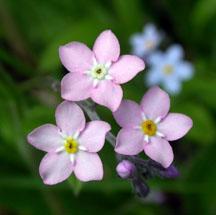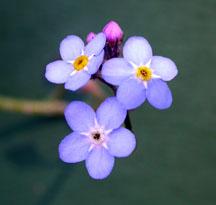Forget-Me-Nots
- Share
- Tweet
- Pin
- Share
There is a non-native wildflower in full bloom now in northeastern Wisconsin that virtually carpets some damp, partially shaded roadsides and trails producing a pure light blue mist. A poll taken of many people living in the Northern Hemisphere would very likely find that this popular widespread plant, steadily expanding in numbers, is one of the all-time favorites – the Forget-Me-Not.
It is a very easy plant to grow in the proper environment, preferring moist, half-shady sites, and even though it can perform either as a perennial or an annual, it always produces so much seed that the planting is permanent once established. My advice is, don’t introduce it to your property unless you really like it. Several years ago we asked our close friends, Ted and Agnes, who at the time had hundreds of them growing in their many beautiful flower beds, “Don’t you consider these flowers dangerous invasives?”
Their reply was, “Oh no, never! We love them so much, and when they’re finished adding such an early wonderful and welcome summer color to our property we simply pull many of them out – piles of them. Next year they’ll be back in blossom as though we had never decreased their number.”
The Forget-Me-Not belongs to the borage family and includes several familiar plants such as Comfrey, Viper’s Bugloss, Puccoon, Hound’s Tongue (a terrible invasive), and Virginia Bluebells. The genus name of the Forget-Me-Not is Myosotis (my-o-SO-tis) and means a mouse’s ear, alluding to the shape of the leaves. The various species are generally considered to be perennials (but sometimes annuals) having slender, sprawling, fine-hairy stems and gray-green, oblong, lance-shaped leaves.
The species we are most familiar with in our area is M. sylvatica (sill-VAT-i-ca), sometimes referred to as the True, Woodland or Garden Forget-Me-Not. It is a common cultivated flower, another Eurasian species that has escaped very extensively to dry as well as damp ground especially along trails and roads through woods, even spreading into woods. The name, sylvatica, refers to the woods or forest. This species is generally more northern in our state but it is spreading rapidly.
The corolla, the accumulation of petals, of this flower is generally a quarter to a third of an inch broad with five rounded lobes, light blue with a yellow eye, a perfect target for visiting insects. Should you come across patches of Forget-Me-Nots having occasional white or pink-flowered specimens, you are enjoying M. sylvatica. We’ve often seen all three colors in one patch. Our good friend, Gary Fewless, an expert botanist at UWGB, maintains that, “Many people will recognize the genus of these plants readily, but there are several species in Wisconsin and errors are frequently made in identification if a key is not carefully followed. A roughly similar species, Myosotis scorpioides, is common in decidedly wet sites.”
M. scorpioides (scor-pee-o-EYE-dees), a common garden species from Eurasia, is thoroughly naturalized in the Midwest and is often abundant in ditches, along streams and rivers and shores, in swampy forests (deciduous as well as coniferous), and wet hollows in woods and in all sorts of wet muck and mud. Its raceme (ra-SEAM) of blossoms often curls over like a scorpion’s tail, and hence its name. This species is much more widely spread in Wisconsin than M. sylvatica.
There is a species, Myosotis alpestris, meaning alpine, that is the state flower of Alaska where it is simply called the Forget-Me-Not. Sometimes confusing the issue of this plant is a closely related, so-called “Alpine Forget-Me-Not,” that grows up to 9,000 feet in the Rocky Mountains but which is an entirely different genus and species, Eritrichium elongatum.
There is yet another species, M. laxa (having very open racemes) that has tiny blossoms, usually an eighth to a fourth of an inch broad, that prefers very wet conditions. The species is common in south-central Wisconsin. It often grows in shallow, slow moving brooks and sometimes becomes so rank that a large mass of them chokes off the flow of water. We have seen streams such as this in northwestern South Dakota.
Henry David Thoreau wrote of this wildflower in his June 12, 1852 journal: “The mouse-ear forget-me-not (Myosotis laxa) has now extended its racemes very much, and hangs over the edge of the brook. It is one of the most interesting minute flowers. It is the more beautiful for being small and unpretending, for even flowers must be modest.”
Tennyson wrote: “The sweet forget-me-nots that grow for happy lovers…” Longfellow had beautiful thoughts of these widely admired plants when he wrote: “Silently, one by one, in the infinite meadows of heaven blossomed the lovely stars, the forget-me-nots of the angels.”
My guess is that some of you have bought and planted wildflower seeds, for example, “A Meadow In A Can,” and now may have quite a few flowers that you never dreamed (or wished) you had bought. A very common seed to be included in these collections is the Forget-Me-Not. Unfortunately these mixtures quite often include seeds not listed on the packages, or in the cans, and others that are mentioned which may be downright dangerous to plant. These are the species that can so easily get out of hand and, rather than producing the wonderful color you expected, become nothing but terrible spreading invasive pests.
Plants such as Yarrow, Redroot Pigweed, Dame’s Rocket (one of the colorful but highly invasive mustards), and Yellow Toadflax are capable of escaping from one’s well-intentioned plantings and invade surrounding nearby areas where they may do considerable damage by crowding out valuable natives.
A romantic legend tells us that a medieval knight dressed in his shining and heavy armor, gathering blue flowers along a stream for his lady love, was suddenly swept away in the river. As he helplessly disappeared, he tossed the bouquet to his lady with the immortal words, “forget me not!”
We too shall continue to enjoy the unforgettable and heavenly blue mists of Forget-Me-Nots each spring – on someone else’s property!





